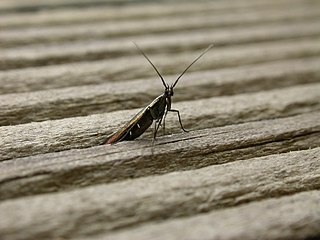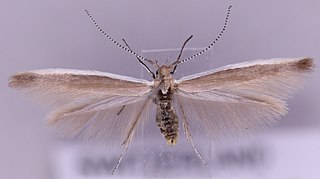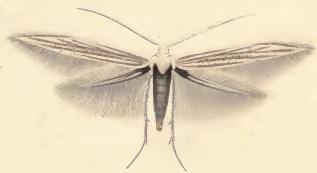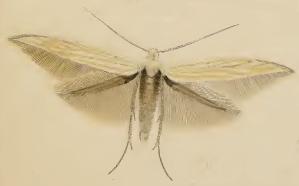
The Coleophoridae are a family of small moths, belonging to the huge superfamily Gelechioidea. Collectively known as case-bearers, casebearing moths or case moths, this family is represented on all continents, but the majority are found in temperate areas of the Northern Hemisphere. They are most common in the Palearctic, and rare in sub-Saharan Africa, South America, and Australia; consequently, they probably originated in northern Eurasia. They are relatively common in houses, they seek out moist areas to rest and procreate.

Coleophora is a very large genus of moths of the family Coleophoridae. It contains some 1,350 described species. The genus is represented on all continents, but the majority are found in the Nearctic and Palaearctic regions. Many authors have tried splitting the genus into numerous smaller ones, but most of these have not become widely accepted.
Calopteryx exul is an endangered species of damselfly in the family Calopterygidae. It is found in Algeria, Morocco, and Tunisia. The largest populations found were located in Northeast Algeria. Its natural habitat is along rivers that have fast flowing water, which are threatened by pollution.
Hibernicus exul was an anonymous Irish Latin poet, grammarian, and dialectician. His works include a comic mock epic, a panegyric to Charlemagne, epigrams of advice to young scholars and a poetic overview of the seven liberal arts.

Coleophora serratella is a moth of the family Coleophoridae. It is found in Europe, Japan (Hokkaido) and North America.

Coleophora limosipennella is a moth of the family Coleophoridae described by Philogène Auguste Joseph Duponchel in 1843. It is found in Europe from Fennoscandia to the Pyrenees, Italy and the Balkan Peninsula and from Great Britain to the Baltic States and Romania. It is an introduced species in North America.

Grevillea exul is a species of flowering plant in the family Proteacae, endemic to New Caledonia.

Paphiopedilum exul is a species of orchid endemic to peninsular Thailand. This orchid is found growing in humus-filled crevices, and is not difficult to grow or flower. Its greenish yellow flowers appear from February to May.

The clover case-bearer or small clover case-bearer is a moth of the family Coleophoridae. It is native to Asia, Europe and North Africa, and has been introduced to Australia and New Zealand.

The metallic coleophora moth is a moth of the family Coleophoridae. It is native to Europe and Armenia, but is an adventive species in the Nearctic realm, where it is found throughout the United States and southern Canada. It has also been recorded from New Zealand, Chile and Argentina.

Coleophora albicostella is a moth of the family Coleophoridae. It is found from Latvia to the Iberian Peninsula, Italy, Greece and Cyprus.
Coleophora zelleriella is a moth of the family Coleophoridae. It is found from Sweden to the Mediterranean Sea and from France to southern Russia. It is not known from the Mediterranean islands.

Coleophora virgatella is a moth of the family Coleophoridae. It is found from Germany and Poland to the Pyrenees, Italy and Greece. It has also been recorded from southern Russia and central Asia.

Coleophora auricella is a moth of the family Coleophoridae. It is found from Germany and Poland to Spain, Italy and Romania. It has also been recorded from southern Russia.

Coleophora colutella is a moth of the family Coleophoridae. It is found in all of Europe, except Great Britain and Ireland. It is an introduced species in North America.

Coleophora millefolii is a moth of the family Coleophoridae. It is found in most of Europe, except Great Britain, Ireland and the Iberian Peninsula.
Coleophora oriolella is a moth of the family Coleophoridae. It is found in Germany and Poland to the Iberian Peninsula, Sardinia, Sicily and Greece and from France to southern Russia.
Coleophora dianthi is a moth of the family Coleophoridae. It is found in most of Europe, Russia, Turkey and Iraq.

Coleophora silenella is a moth of the family Coleophoridae. It is found in most of Europe, except Fennoscandia, Ireland, Greece, Portugal and Ukraine.
The New Caledonian nightjar is a poorly known species of nightjar in the family Caprimulgidae. It is endemic to New Caledonia.








